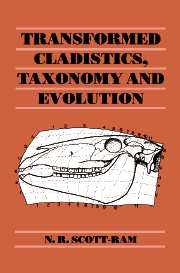Book contents
- Frontmatter
- Contents
- Preface
- Introduction
- PART I ISSUES PERTAINING TO THE PHILOSOPHY OF SCIENCE
- PART II THE STATUS OF THEORETICAL CLASSIFICATIONS
- PART III THE STATUS OF DESCRIPTIVE CLASSIFICATIONS
- 4 Phenetics and the descriptive attitude
- 5 Transformed cladistics and the methodological turn
- 6 Transformed cladistics and evolution
- Notes
- Bibliography
- Author index
- Subject index
6 - Transformed cladistics and evolution
Published online by Cambridge University Press: 21 October 2009
- Frontmatter
- Contents
- Preface
- Introduction
- PART I ISSUES PERTAINING TO THE PHILOSOPHY OF SCIENCE
- PART II THE STATUS OF THEORETICAL CLASSIFICATIONS
- PART III THE STATUS OF DESCRIPTIVE CLASSIFICATIONS
- 4 Phenetics and the descriptive attitude
- 5 Transformed cladistics and the methodological turn
- 6 Transformed cladistics and evolution
- Notes
- Bibliography
- Author index
- Subject index
Summary
In this final chapter my aim will be to examine whether transformed cladistics succeeds on its own terms. That is, do the transformed cladists uphold a theoretically neutral methodology (with respect to evolutionary assumptions) in classification construction? If it can be shown that homologies define hierarchies of groups in nature in the absence of evolutionary assumptions, then the resultant claim that these hierarchies are evidence of causal necessity (which would imply that they are natural) could also be upheld. I will therefore be examining questions (1) and (2) (p. 145) with a view to arguing that if the transformed cladists wish to avoid a Platonic world view, then their methods are unintelligible except in the light of evolutionary theory.
In order to show that there are no evolutionary assumptions in their methodology, transformed cladists must substantiate the claim that groups exist regardless of whether some causal theory is needed to explain their existence. For the transformed cladist this existence is guaranteed by congruence of homologies, such that homologies may be hypothesised and tested by a rational procedure that has no necessary dependence on evolution. Two elements must be teased apart in this methdology. First, what constitutes the structural model and, second, the methods for realising such a model.
- Type
- Chapter
- Information
- Transformed Cladistics, Taxonomy and Evolution , pp. 160 - 184Publisher: Cambridge University PressPrint publication year: 1990



